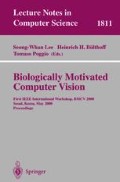Abstract
This paper presents a method that generates a mosaic image from multiple images or a sequence of images without any assumptions on camera intrinsic parameters or camera motion. The most appropriate transform model is automatically selected according to the global alignment error. Given a set of images, the optimal parameters for a 2D projective transform model are computed using a linear least squares estimation method and then iterative nonlinear optimization method. When the error exceeds a predefined limit, a more simple transform model is applied to the alignment. Our experiments showed that false alignments are reduced even in the case of 360° panoramic images.
Access this chapter
Tax calculation will be finalised at checkout
Purchases are for personal use only
Preview
Unable to display preview. Download preview PDF.
References
Szeliski, R.: Image mosaicing for tele-reality applications, Technical Report CRL 94/2, DEC Cambridge Research Lab (1994)
Sawhney, H. S. et al.: VideoBrush™: Experiences with consumer video mosaicing, WACV’98 (1998) 56–62
Hartley, R. I.: Theory and Practice of Projective Rectification, International Journal of Computer Vision, 35(2), nov (1999) 1–16
Amstrong, M., Zisserman, A., Beardsley, P. A.: Euclidean structure form uncali-brated images, BMCV’94 (1994) 509–518
Pollefeys, M., Koch, K., Gool, L. V.: Self-calibration and metric reconstruction in spite of varying and unknown internal camera parameters, Proc. IEEE Int. Conf. on Comp. Vis. (1998) 90–95
Szeliski, R.: Video mosaics for virtual environments, IEEE Computer Graphics and Applications, 16(2) (1996) 22–30
Zhu, Z.: Xu, G., Riseman, E. M., Hanson, A. R.: Fast generation of dynamic and multiresolution 360° panorama from video sequences, Proceedings of IEEE Int’l Conf. On Multimedia Computing and Systems (1999) 7–11
Faugeras, O. et al.: Real time correlation-based stereo: algorithm, implementation and applications, INRIA Technical Report (1993)
Gümü§tekin, S., Hall, R. W.: Mosaic image generation on a flattened gaussian sphere, WACV’96 (1996) 50–55
Author information
Authors and Affiliations
Editor information
Editors and Affiliations
Rights and permissions
Copyright information
© 2000 Springer-Verlag Berlin Heidelberg
About this paper
Cite this paper
Park, JS., Chang, DH., Park, SG. (2000). Automatic Generation of Photo-Realistic Mosaic Image. In: Lee, SW., Bülthoff, H.H., Poggio, T. (eds) Biologically Motivated Computer Vision. BMCV 2000. Lecture Notes in Computer Science, vol 1811. Springer, Berlin, Heidelberg. https://doi.org/10.1007/3-540-45482-9_34
Download citation
DOI: https://doi.org/10.1007/3-540-45482-9_34
Published:
Publisher Name: Springer, Berlin, Heidelberg
Print ISBN: 978-3-540-67560-0
Online ISBN: 978-3-540-45482-3
eBook Packages: Springer Book Archive

